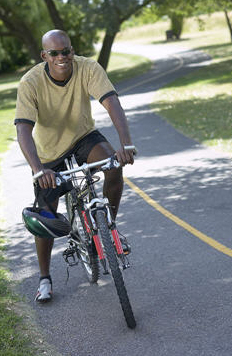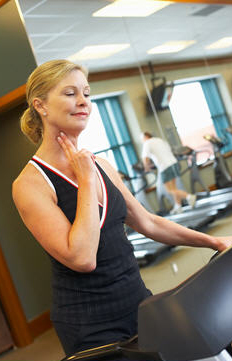Keeping Your Student Motivated
Consider how determination, motivation and self-discipline can help individuals stay on track. Often, people become frustrated by a lack of results from fitness programs and may lose desire to continue and give up. Many people begin fitness programs with unrealistic goals and expect quick results. Explain to your students how the body works and the time needed for changes to be noticed as a way to prevent frustration.
Encourage your students to seek out new ways to maintain interest in fitness, so that fitness becomes a way of life, and to set realistic goals and add rewards when they are achieved. It can be difficult to stay motivated and committed to exercising, despite good intentions. The following is a list of tips for a successful fitness program that may help you work with your students to overcome these barriers.
As an instructor you can work with your students to:
 Make it fun. Taking part in enjoyable activities that are appropriate to the student and relevant to their goals will ensure commitment to an exercise program and will maintain motivation. Students might feel uncomfortable and intimidated in a new fitness setting due to accessibility and social factors. Explore ways to build in support from others. Provide opportunities in class for students to interact with one another and encourage a workout buddy. In addition, vary the routine in order to prevent boredom and plateaus. Make it fun. Taking part in enjoyable activities that are appropriate to the student and relevant to their goals will ensure commitment to an exercise program and will maintain motivation. Students might feel uncomfortable and intimidated in a new fitness setting due to accessibility and social factors. Explore ways to build in support from others. Provide opportunities in class for students to interact with one another and encourage a workout buddy. In addition, vary the routine in order to prevent boredom and plateaus.
- Stay cool and keep hydrated. Ensure students drink water before, during and after a workout to avoid dehydration. To avoid overheating, working out in a cool environment, wearing cool breathable clothing, and using cooling devices can help.
- Provide a challenge. Over time the body conditions itself for a particular activity. Students should gradually increase the intensity of a workout to continue to improve strength and endurance when it is no longer challenging. A student can increase the duration of your cardio workout in small increments (add 2 minutes to your walk) or increase the intensity to a strength training program by adding repetitions or sets (3 sets of 10 repetitions to 3 sets of 12 repetitions).
- Make it complete. Fitness is more than just a cardiovascular workout. Make sure all aspects of fitness are incorporated to make a well-rounded exercise program. Aerobic activity should be done at least two to three times a week, strength training at least twice a week, and flexibility and relaxation should be included throughout the week.
- Start slowly. Doing too much too soon only leads to sore muscles and unwillingness to do the same routine again. If a workout causes soreness, then too much is being done. Tell your students to workout for a shorter time, use less weight or decrease the intensity, and over time gradually add more.
- Listen to the body. Encourage students to avoid comparing themselves to others or to do exactly what others might be doing. This could lead to injury, feeling discouraged and unmotivated. They should pay attention to their body and adjust a workout accordingly. Remind them to challenge themselves or make modifications when appropriate. Each
 workout may be different each day due to symptoms, how one might be feeling, any injuries, or the time of day they are working out. Lower intensity of exercise or duration during periods of exacerbations and overheating. workout may be different each day due to symptoms, how one might be feeling, any injuries, or the time of day they are working out. Lower intensity of exercise or duration during periods of exacerbations and overheating.
- Pacing. During any strenuous exercise it is important to work at a level at which one can still breathe and talk. Students should assess their body throughout an exercise session to avoid overexertion, which can result in extreme fatigue lasting for up to a few days.
- Make fitness a habit. Working-out must be thought of as a “life-long” habit and a behavioral change, something done without thinking or talking yourself in or out of. You would not consider brushing your teeth as an option, so encourage your students to treat exercise as another part of daily routine.
- Set realistic goals. Work with your students to begin with a basic program, including all components of fitness. Be sure that their goals are realistic and achievable for now. Setting unrealistic goals or only long-term goals [those that take months to achieve], is a formula for failure, lack of self-confidence and self-efficacy. Students should set short-term goals that are attainable, and once they are reached, new ones can be set. Recognizing when students are improving and maintaining progress on their fitness goals will help build confidence and promote motivation over time.
- Exercise throughout the day. An hour block of time for exercise can seem overwhelming or even impossible. Students can break it up into smaller chunks throughout the day. Research has shown that you can see benefits when exercising three times a day in 20-minute increments. All activity adds up by the end of the day, so individuals can take advantage of free moments. Adding exercise to daily activities, like taking the stairs instead of the elevator, doing calf raises while standing in line, and tightening your glutes and thighs while sitting at a red light, commuting to work or errands on foot or by bike (including adaptive cycles) is an easy way to incorporate activity throughout the day. These small increments can add up and count toward a total fitness program.
If an individual is having difficulty initiating or maintaining an exercise/physical activity program, recommend that they consult with a healthcare or fitness professional with expertise in MS who can provide specific exercises that will increase success and adherence with an activity program. Always remember, of course, to recommend that people consult with their physician if they have any questions about whether a new exercise program is right for them or if their symptoms change.
|